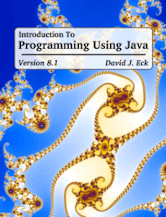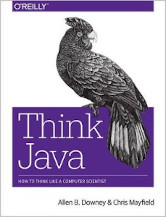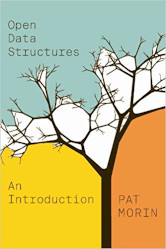Last Updated on September 19, 2024
Java is a general-purpose, concurrent, class-based, object-oriented, high-level programming language and computing platform first released by Sun Microsystems in 1995. It is related in some ways to C and C++, in particular with regard to its syntax, and borrows a few ideas from other languages. Java applications are compiled to bytecode that can run on any Java virtual machine (JVM) regardless of computer architecture.
Java is designed to be simple enough that many programmers can quickly become proficient in the language. It’s one of the most popular programming languages especially for client-server web applications.
Some popularity indexes show that Java holds the top spot with C. The respected TIOBE Index shows Java remains the most popular programming language.
We recommend the following Java books. All of them are free to download.
1. Introduction to Programming Using Java, Eighth Edition by David J. Eck
 The Eighth Edition of Introduction to Programming Using Java is a free, on-line textbook on introductory programming, which uses Java as the language of instruction.
The Eighth Edition of Introduction to Programming Using Java is a free, on-line textbook on introductory programming, which uses Java as the language of instruction.
This book is directed mainly towards beginning programmers, although it might also be useful for experienced programmers who want to learn something about Java.
The book isn’t designed to provide complete coverage of the Java language, but it’s an excellent introductory text.
2. Think Java – How to Think Like a Computer Scientist by Allen B. Downey, Chris Mayfield
 Think Java is an excellent introduction to Java programming for beginners.
Think Java is an excellent introduction to Java programming for beginners.
Chapters cover:
- Variables and types
- Input and output
- Void methods
- Conditionals and logic – includes conditional execution, alternative execution, chained and nested conditionals, the return statement, type conversion, recursion, and stack diagrams for recursive methods
- Value methods including composition, overloading Boolean expressions and methods, and logical operators
- Iteration and loops examines the while statement, tables, two-dimensional tables, and encapsulation
- Strings and things – characters, length, traversal, run-time errors, reading documentation, the indexOf method, looping and counting and more
- Mutable objects – use two objects from Java libraries, Point and Rectangle
- Create your own objects
- Arrays – a set of values where each value is identified by an index
- Arrays of Objects – defines a Card class and write methods that work with Cards and arrays of Cards
- Objects of Arrays – creates a Deck class and write methods that operate on Decks
- Object-oriented programming – presents object-oriented programming (OOP) and transforms the Card and Deck classes into a more OOP style
- GridWorld: Part 3
- Appendices: Graphics, Input and Output in Java, Program development, and Debugging
Permission is granted to copy, distribute, transmit and adapt this work under a Creative Commons Attribution-NonCommercial-ShareAlike 3.0 Unported License.
You can order a paperback version from Amazon.
3. Open Data Structures by Pat Morin
 Open Data Structures covers the implementation and analysis of data structures for sequences (lists), queues, priority queues, unordered dictionaries, ordered dictionaries, and graphs.
Open Data Structures covers the implementation and analysis of data structures for sequences (lists), queues, priority queues, unordered dictionaries, ordered dictionaries, and graphs.
The book and is released under a Creative Commons Attribution License. Read the book for free – released in HTML, PDF, and the book’s LaTeX, Java/C++/Python sources can be downloaded from GitHub. There is also a paperback version to buy. The book has been translated into Slovenian and Turkish.
Chapters cover:
- Array-Based Lists – implementations of the List and Queue interfaces where the underlying data is stored in an array, called the backing array
- Linked Lists – studies implementations of the List interface, using pointer-based data structures instead of arrays
- Skiplists – a data structure which has a variety of uses
- Hash Tables – focuses on two of the most common implementations of hash tables: hashing with chaining and linear probing
- Binary Trees – introduces one of the most fundamental structures in computer science
- Random Binary Search Trees
- Scapegoat Trees – a binary search tree data structure
- Red-Black Trees – a version of binary search trees with logarithmic height
- Heaps – discusses two implementations of the priority Queue data structure
- Sorting Algorithms – discusses algorithms for sorting a set of n items
- Graphs – study two representations of graphs and basic algorithms that use these representations
- Data Structures for Integers
- External Memory Searching
The book is available in HTML, PDF, Java sources.
Next page: Page 2 – Java Application Development on Linux and more books
Pages in this article:
Page 1 – Introduction to Programming Using Java and more books
Page 2 – Java Application Development on Linux and more books
Page 3 – Java Programming for Kids and more books
Page 4 – Object Oriented Programming using Java and more books
Page 5 – Java Structures and more books
All books in this series:
| Free Programming Books | |
|---|---|
| Ada | ALGOL-like programming language, extended from Pascal and other languages |
| Agda | Dependently typed functional language based on intuitionistic Type Theory |
| Arduino | Inexpensive, flexible, open source microcontroller platform |
| Assembly | As close to writing machine code without writing in pure hexadecimal |
| Awk | Versatile language designed for pattern scanning and processing language |
| Bash | Shell and command language; popular both as a shell and a scripting language |
| BASIC | Beginner’s All-purpose Symbolic Instruction Code |
| C | General-purpose, procedural, portable, high-level language |
| C++ | General-purpose, portable, free-form, multi-paradigm language |
| C# | Combines the power and flexibility of C++ with the simplicity of Visual Basic |
| Clojure | Dialect of the Lisp programming language |
| ClojureScript | Compiler for Clojure that targets JavaScript |
| COBOL | Common Business-Oriented Language |
| CoffeeScript | Transcompiles into JavaScript inspired by Ruby, Python and Haskell |
| Coq | Dependently typed language similar to Agda, Idris, F* and others |
| Crystal | General-purpose, concurrent, multi-paradigm, object-oriented language |
| CSS | CSS (Cascading Style Sheets) specifies a web page’s appearance |
| D | General-purpose systems programming language with a C-like syntax |
| Dart | Client-optimized language for fast apps on multiple platforms |
| Dylan | Multi-paradigm language supporting functional and object-oriented coding |
| ECMAScript | Best known as the language embedded in web browsers |
| Eiffel | Object-oriented language designed by Bertrand Meyer |
| Elixir | Relatively new functional language running on the Erlang virtual machine |
| Erlang | General-purpose, concurrent, declarative, functional language |
| F# | Uses functional, imperative, and object-oriented programming methods |
| Factor | Dynamic stack-based programming language |
| Forth | Imperative stack-based programming language |
| Fortran | The first high-level language, using the first compiler |
| Go | Compiled, statically typed programming language |
| Groovy | Powerful, optionally typed and dynamic language |
| Haskell | Standardized, general-purpose, polymorphically, statically typed language |
| HTML | HyperText Markup Language |
| Icon | Wide variety of features for processing and presenting symbolic data |
| J | Array programming language based primarily on APL |
| Java | General-purpose, concurrent, class-based, object-oriented, high-level language |
| JavaScript | Interpreted, prototype-based, scripting language |
| Julia | High-level, high-performance language for technical computing |
| Kotlin | More modern version of Java |
| LabVIEW | Designed to enable domain experts to build power systems quickly |
| LaTeX | Professional document preparation system and document markup language |
| Lisp | Unique features - excellent to study programming constructs |
| Logo | Dialect of Lisp that features interactivity, modularity, extensibility |
| Lua | Designed as an embeddable scripting language |
| Markdown | Plain text formatting syntax designed to be easy-to-read and easy-to-write |
| Objective-C | Object-oriented language that adds Smalltalk-style messaging to C |
| OCaml | The main implementation of the Caml language |
| Pascal | Imperative and procedural language designed in the late 1960s |
| Perl | High-level, general-purpose, interpreted, scripting, dynamic language |
| PHP | PHP has been at the helm of the web for many years |
| PostScript | Interpreted, stack-based and Turing complete language |
| Prolog | A general purpose, declarative, logic programming language |
| PureScript | Small strongly, statically typed language compiling to JavaScript |
| Python | General-purpose, structured, powerful language |
| QML | Hierarchical declarative language for user interface layout - JSON-like syntax |
| R | De facto standard among statisticians and data analysts |
| Racket | General-purpose, object-oriented, multi-paradigm, functional language |
| Raku | Member of the Perl family of programming languages |
| Ruby | General purpose, scripting, structured, flexible, fully object-oriented language |
| Rust | Ideal for systems, embedded, and other performance critical code |
| Scala | Modern, object-functional, multi-paradigm, Java-based language |
| Scheme | A general-purpose, functional language descended from Lisp and Algol |
| Scratch | Visual programming language designed for 8-16 year-old children |
| SQL | Access and manipulate data held in a relational database management system |
| Standard ML | General-purpose functional language characterized as "Lisp with types" |
| Swift | Powerful and intuitive general-purpose programming language |
| Tcl | Dynamic language based on concepts of Lisp, C, and Unix shells |
| TeX | Markup and programming language - create professional quality typeset text |
| TypeScript | Strict syntactical superset of JavaScript adding optional static typing |
| Vala | Object-oriented language, syntactically similar to C# |
| VHDL | Hardware description language used in electronic design automation |
| VimL | Powerful scripting language of the Vim editor |
| XML | Rules for defining semantic tags describing structure ad meaning |
